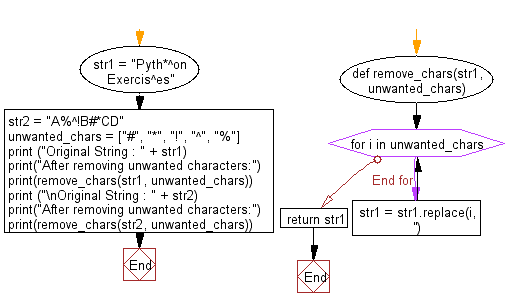Python: Remove unwanted characters from a given string
Remove unwanted characters in string.
Write a Python program to remove unwanted characters from a given string.
Sample Solution:
Python Code:
# Define a function to remove unwanted characters from a string
def remove_chars(str1, unwanted_chars):
# Iterate through each unwanted character
for i in unwanted_chars:
# Use the replace() method to remove occurrences of the unwanted character from the string
str1 = str1.replace(i, '')
# Return the modified string without unwanted characters
return str1
# Initialize two strings
str1 = "Pyth*^on Exercis^es"
str2 = "A%^!B#*CD"
# Specify a list of unwanted characters
unwanted_chars = ["#", "*", "!", "^", "%"]
# Print the original string and a message indicating the removal of unwanted characters
print("Original String : " + str1)
print("After removing unwanted characters:")
# Call the function to remove unwanted characters and print the result
print(remove_chars(str1, unwanted_chars))
# Print a newline for better formatting
print("\nOriginal String : " + str2)
print("After removing unwanted characters:")
# Call the function to remove unwanted characters and print the result
print(remove_chars(str2, unwanted_chars))
Sample Output:
Original String : Pyth*^on Exercis^es After removing unwanted characters: Python Exercises Original String : A%^!B#*CD After removing unwanted characters: ABCD
Flowchart:

For more Practice: Solve these Related Problems:
- Write a Python program to remove all non-alphanumeric characters from a string using regular expressions.
- Write a Python program to filter a string and return only letters and digits by iterating over each character.
- Write a Python program to implement a function that cleans a string by stripping punctuation and special symbols.
- Write a Python program to use the translate() method with a translation table to remove unwanted characters.
Go to:
Previous: Write a Python program to check whether a given string contains a capital letter, a lower case letter, a number and a minimum length.
Next: Write a Python program to remove duplicate words from a given string.
Python Code Editor:
What is the difficulty level of this exercise?
Test your Programming skills with w3resource's quiz.
